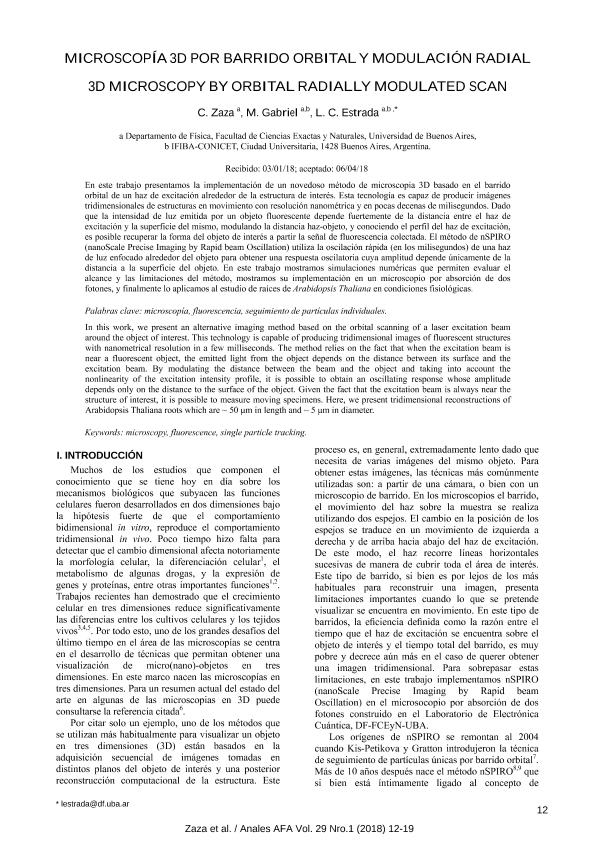Artículo
En este trabajo presentamos la implementación de un novedoso método de microscopía 3D basado en el barrido orbital de un haz de excitación alrededor de la estructura de interés. Esta tecnología es capaz de producir imágenes tridimensionales de estructuras en movimiento con resolución nanométrica y en pocas decenas de milisegundos. Dado que la intensidad de luz emitida por un objeto fluorescente depende fuertemente de la distancia entre el haz de excitación y la superficie del mismo, modulando la distancia haz-objeto, y conociendo el perfil del haz de excitación, es posible recuperar la forma del objeto de interés a partir la señal de fluorescencia colectada. El método de nSPIRO (nanoScale Precise Imaging by Rapid beam Oscillation) utiliza la oscilación rápida (en los milisegundos) de una haz de luz enfocado alrededor del objeto para obtener una respuesta oscilatoria cuya amplitud depende únicamente de la distancia a la superficie del objeto. En este trabajo mostramos simulaciones numéricas que permiten evaluar el alcance y las limitaciones del método, mostramos su implementación en un microscopio por absorción de dos fotones, y finalmente lo aplicamos al estudio de raíces de Arabidopsis Thaliana en condiciones fisiológicas. In this work, we present an alternative imaging method based on the orbital scanning of a laser excitation beam around the object of interest. This technology is capable of producing tridimensional images of fluorescent structures with nanometrical resolution in a few milliseconds. The method relies on the fact that when the excitation beam is near a fluorescent object, the emitted light from the object depends on the distance between its surface and the excitation beam. By modulating the distance between the beam and the object and taking into account the nonlinearity of the excitation intensity profile, it is possible to obtain an oscillating response whose amplitude depends only on the distance to the surface of the object. Given the fact that the excitation beam is always near the structure of interest, it is possible to measure moving specimens. Here, we present tridimensional reconstructions of Arabidopsis Thaliana roots which are ~ 50 μm in length and ~ 5 μm in diameter.
Microscopía 3D por barrido orbital y modulación radial
Título:
3D microscopy by orbital radially modulated scan
Fecha de publicación:
04/2018
Editorial:
Asociación Física Argentina
Revista:
Anales de la Asociación Física Argentina
ISSN:
1850-1168
Idioma:
Español
Tipo de recurso:
Artículo publicado
Clasificación temática:
Resumen
Palabras clave:
FLUORESCENCE
,
MICROSCOPY
,
SINGLE PARTICLE TRACKING
Archivos asociados
Licencia
Identificadores
Colecciones
Articulos(IFIBA)
Articulos de INST.DE FISICA DE BUENOS AIRES
Articulos de INST.DE FISICA DE BUENOS AIRES
Citación
Zaza, María Cecilia; Gabriel, Manuela; Estrada, Laura Cecilia; Microscopía 3D por barrido orbital y modulación radial; Asociación Física Argentina; Anales de la Asociación Física Argentina; 29; 1; 4-2018; 12-19
Compartir
Altmétricas




